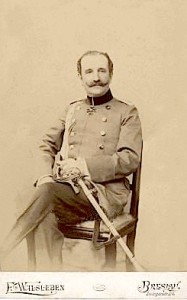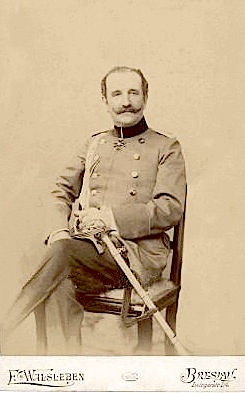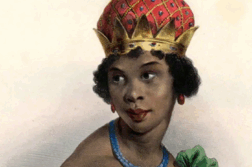SCHOLARS AND TABLOIDS seem to be worlds apart. One serves the higher purpose of knowledge, the other wallows in scandal. But how wide is the gulf between them really? Or is there any gulf at all? Scandals as we know them are a product of the mass media and the New Journalism that emerged in the UK and the U.S. at the end of the 19th century. But also Germany in the age of Kaiser Wilhelm II had its fair share of scandals. Historians and sociologists have shown that the heated discussions in the press were not just driven by sensationalism but were also fed by contemporary academic discourses.
Psychiatrist Richard von Krafft-Ebing died in 1902, but a year later his ideas about sexual inversion would inform the professional discourse about human sexuality that arose in the wake of the highly publicized trial of child-murderer Andreas Dippold. This scandal, which rocked Germany for months and years, has recently been retold by Michael Hagner in Der Hauslehrer: Die Geschichte eines Kriminalfalls (“The House Teacher: The History of a Criminal Case”). Coincidentally enough, another recent book tells the history of a contemporary episode known as the Eulenburg affair, which is told by Norman Domeier in (Der Eulenburg-Skandal: Eine politische Kulturgeschichte des Kaiserreichs (“The Eulenburg Scandal: A Political Culture History of the Kaiser Reich”), a scandal that kept the public excited for nearly three years starting in 1906. Finally, as luck would have it, an authoritative biography of Krafft-Ebing has also appeared of late in Germany, Heinrich Ammerer’s Am Anfang war die Perversion (“In the Beginning Was the Perversion”).
The Dippold Trial
On the afternoon of March 10, 1903, a doctor was summoned to a remote timber house in the mountains of the central German region of Franconia. Supposedly, an adolescent boy was severely ill. But before the doctor could see the patient, the boy’s house teacher engaged him in a lengthy conversation. The teacher—young student Andreas Dippold—apparently needed someone to talk to. For more than two hours he ran on about the boy’s moral defects, foremost among them his incessant masturbation, which could not be stopped even by the harshest corporal punishment. When Dippold finally showed the doctor to the boy’s room, it became clear that the boy had died before the doctor was even summoned. But the end of fourteen-year-old Heinz Koch’s personal ordeal was to mark the beginning of a major public scandal.
Dippold was arrested and put on trial for manslaughter of Heinz Koch and for grievous bodily harm to Heinz’s younger brother Joachim. At the trial, Andreas Dippold justified his repeated beatings of the two boys as a response to the their alleged habit of masturbation. Surviving letters from the winter of 1902–03 show that Heinz and Joachim’s mother Rosalie Koch gave Dippold explicit permission to enforce this strict regime. After all, they were only following the prescriptions of Marten and Tissot’s 18th-century pamphlets against “self-pollution,” which continued to hold sway in the medical discourse all these years later. At the trial, however, the Koch parents claimed that Dippold had deceived them and was not following their directives. As the director of Deutsche Bank, Herr Koch was an immensely wealthy member of the ruling elite, and his strategy of denial largely worked. The judge ruled that the Kochs had been the innocent victims of a trickster. However, he then surprised everyone by sentencing Dippold to “only” eight years in jail rather than the maximum of fifteen years. Was this the silent protest of a judge who believed that the parents had willfully overlooked the psychological warning signs?
In any case, this lenient verdict caused another public uproar, which in turn caused professionals from various disciplines to revisit the Dippold case, which threatened their credibility. In his defense, Dippold had shown extensive knowledge of the current discourse in education, law, and medicine, and his use of scientific and scholarly theories had apparently held some sway—hence the lenient sentence. With some justification the question was raised: if a convicted criminal could justify his behavior with recourse to such theories, maybe it’s time to question the soundness of the theories themselves.
An important figure in this context was Maximilian Harden, Germany’s leading journalist at the time. In his weekly magazine Die Zukunft (“The Future”), he diagnosed Dippold as suffering from “contrary sexual orientation with marked sadism.” This was as damning as a public verdict could get at the time. And it tells more about the journalist than about the accused. Harden could diagnose Dippold with “contrary sexual orientation,” i.e. homosexuality, only because he overlooked at least two facts: Dippold had had a fiancée, and the engagement had been dissolved after Dippold contracted syphilis from a female prostitute. Similarly, if the charge of sadism had been accepted by the court, Dippold would have ended in a psychiatric ward, not in prison. But to the public, child-murderer Dippold was a monster, and homosexuality and sadism were characteristics this public was willing to attribute to monsters.
In 1903, when the Dippold trials caused such heated debates, terms like sadism, masochism, and fetishism were of quite recent origin. They had been introduced by Richard von Krafft-Ebing, a psychiatrist of international renown and pioneer sexologist, about a decade and a half before. Krafft-Ebing was the author of the provocatively titled Psychopathia Sexualis, in which he classified a range of “perversions,” as he judged them, and he also explained some clinical facts of life to his repressed peers. The first edition was published in 1886, and the twelfth edition—the last one to be revised by Krafft-Ebing himself—some fifteen years later. Psychopathia Sexualis covered everything from exhibitionism to nymphomania to homosexuality, and its racy subject matter was certainly a major reason for its success as an international bestseller.
The young Richard Krafft-Ebing, born in 1840, was a liberal-minded scholar who didn’t care much about his noble ancestry. What he had learned from his family, however, was the value of professional networks. Richard’s father was a civil servant in the southwest German state of Baden, and was posted to a new station every couple of years. Richard grew up with his grandfather Karl Mittermaier, a prominent lawyer and professor in Heidelberg. In Mittermaier’s house, Richard experienced firsthand the practical workings of a far-reaching social network. Because much of the professional talk and correspondence dealt with legal affairs, later on he was well prepared as a doctor to cope with legal and forensic matters.
After holding professional posts in Strasbourg and Illenau, Krafft-Ebing married and settled down in Graz, Austria, later moving to Vienna. Throughout his professional life, he showed his patients great respect. He regarded the mad as mentally ill people in need of treatment and compassion rather than as sinners and criminals to be locked away out of sight. Psychopathia Sexualis had originally been just another piece in Krafft-Ebing’s constant campaign to promote the young discipline of psychiatry to non-specialist doctors and legal practitioners, especially those confronted with pleas of insanity. Educated readers from the upper and middle classes would send him their own or their patients’ case histories, some of which were included in later editions. Krafft-Ebing became a champion for the abolition of those paragraphs in German and Austrian law that criminalized homosexual acts between adults (§175 in the German Empire, §129 in the Austrian Habsburg monarchy).
The case studies Krafft-Ebing presented in the Psychopathia Sexualis contained several moving accounts of the plight of homosexuals as unhappy singles, unhappy husbands, or unhappy fathers. These accounts had a liberating effect on readers who recognized their own feelings. Framing their condition as a disease with natural causes was actually an improvement over the moral abhorrence leveled at these men by religious and other institutions. In the later 20th century, Krafft-Ebing has been criticized for pathologizing homosexuals. One should bear in mind, however, that he was sought out by people who were troubled by their circumstances. Those who were self-confident and not at all troubled by their urges or conduct rarely came into his office. For example, once he was presented by the police with a man they had arrested for committing homosexual acts. The man declared that he was in perfect health and that there was nothing wrong with what he did. As a professional psychiatrist and leading authority on current morals, the doctor was struggling to accept such a view.
Krafft-Ebing was a pioneer sexologist. His clinical approach enabled the educated masses to talk about a subject that hitherto had been shrouded in taboo. In the end, however, other approaches to the nature of human sexuality proved more enduring. At the end of the 19th century, a craze for hypnosis swept Viennese society, and Krafft-Ebing conducted some experiments in this field. His established colleagues were appalled, but younger doctors were more open. One of them told the Vienna Fremden-Blatt in 1893: “As for the value of hypnosis for science, I must again side with Professor Krafft-Ebing.” The young doctor’s name was Sigmund Freud.
The Eulenburg Affair
Undoubtedly one of the most under-appreciated events in German historiography, the Eulenburg affair has generally been regarded as either a “homosexual scandal” or a personal intrigue involving some courtiers, politicians, and journalists. These aspects are correct, but they fail to do justice to the scale and complexity of the five high-profile trials that fed the ravenous popular press for months, a scandal from which emerged revelations that nearly brought down the monarchy. Norman Domeier has analyzed some 5,000 newspaper articles from the years 1906 to 1908 and shown that the writers were well aware that they were living through momentous times.

At the outset, there was the Zelig-like Maximilian Harden. Having concocted on the fly the story that Andreas Dippold was a homosexual some three years earlier, he now had a much more convincing case to advance to his eager readers. His claim: Kuno von Moltke, commander of the Ber-lin garrison, General of the Prussian army, was a homosexual! Kuno’s ex-wife Lily had given Harden a copy of their divorce files, which proved this claim—while also incriminating Harden’s real target, Prince Philipp von Eulenburg.
For two decades, Eulenburg had been the closest friend and political advisor of Kaiser Wilhelm II. Harden now charged Eulenburg with heading a “camarilla,” a secret circle of friends around the throne who acted against the interests of the German nation and empire. Harden had had his fair share of libel charges and even prison sentences, so he proceeded with extreme caution. In November 1906, he published a mere allusion, a somewhat cryptic dialogue between the “the harpist” and “the sweet one” about their “little darling.” While the general public was puzzled by this strange piece of writing, Eulenburg (“the harpist”) and Moltke (“the sweet one”) knew that Harden was after them.
Through intermediaries, Eulenburg negotiated with Harden. Eulenburg would go into exile in Switzerland, officially protesting poor health. Harden would keep quiet. That could have been it. There would have been no sensational trials that would be compared to the Dreyfus affair in France only a decade before. But after only three months, Eulenburg returned to Berlin, to his place in the sun orbiting the Kaiser. Harden got more explicit with his attacks on the “camarilla”—nothing shocking for a citizen of a modern democracy, but a bombshell for the citizens of Germany. The revelation that Eulenburg and Moltke, at least nominally subjects to the monarch too, were allowed to address His Majesty as their “little darling” was too much for conservative monarchists and socialist critics to bear.
Harden’s first attack appeared on March 13, 1907. During the next three weeks nearly everyone in Germany and indeed the whole of Europe was talking about the scandal, the most prominent exception being Wilhelm II himself. There was simply no one in his entourage who wanted to be the bearer of bad news. In the end, crown prince Wilhelm informed his father. The press cheered the 24-year old prince for his “first political deed.” Wilhelm II immediately dropped his two favorites. This was his last chance to end this affair quietly, but onstentatious monarch that he was, Wilhelm gave out the catchy order: “gereinigt oder gesteinigt,” meaning Moltke would get his name “cleared” or he would be “stoned.”
The general had been shamed by Harden, and the honor code of the time forced him to take action against the insulting party. The general suffered his first defeat when the journalist refused a duel. Now the only option for Moltke to get his name cleared was to file a private libel suit against Harden. This was exactly what Harden had wanted all along: a public forum where he would be “forced” to provide further evidence to substantiate his initial claim. The situation was somewhat paradoxical, with the defendant being in charge of the proceedings. Moltke conceded at once that “as an old soldier” he was no rhetorical match for Harden and his lawyer. The revelations from the trial were extraordinary even by today’s tabloid standards. The European public learned from Moltke’s ex-wife Lily that the general had once declared his undying love to a handkerchief left behind by Eulenburg; that she had repeatedly beaten him because of his inability to satisfy her sexually; and—his greatest humiliation symbolically—that he had failed to stop her when Lily tore off the epaulettes from his uniform. Those were the scenes from a marriage, one that had begun with the Kaiser himself acting as best man at the wedding.
It now dawned on Wilhelm II that he had made a mistake. While the monarchy had successfully reined in parliament for decades, the king was in no way prepared to cope with the public pressures that were bearing down from the courtroom and the press. While Lily’s testimony had caused a sensation, there was still some hope for General von Moltke as long as the credibility of his ex-wife could be questioned. But then came the ultimate sensation from Magnus Hirschfeld, who was becoming increasingly prominent as a physician and homosexual rights activist. As an expert witness, he presented forensic evidence to the stunned audience, including Moltke himself, indicating that the general was indeed a homosexual, though he was probably not aware of it. The jury was convinced and acquitted Harden. A personal friend of the Kaiser had been exposed. Upon receiving the news, Wilhelm II could not believe that he’d been “defeated” by a jury made up of a milk merchant and a butcher. He had a nervous breakdown.
For the following few months, the moral, military, and even political equilibrium of the empire were thrown into a cocked hat. The Times of London had initially reported on the “Court Scandals in Berlin,” but in the end it was just “the German Scandal.” The old order survived the upheaval somehow, but at the price of an increasingly chauvinistic public discourse. National feelings had been hurt and needed to be restored. This fact is still missing in traditional political histories of events leading up to World War I.
Eulenburg was finally caught by Harden. In two subsequent trials, Eulenburg swore under oath never to have committed homosexual acts. After that, Harden presented two sins from the prince’s past: two Bavarians, young lads when Eulenburg had spent his holidays on Lake Starnberg near Munich some twenty years before, now testified against him. Eulenburg’s perjury was obvious, and for only the second time in German history a nobleman of such a high rank was prosecuted.
The End of the Illness Model
Norman Domeier’s study deserves an English translation, because it not only restores the Eulenburg affair to its proper place in German history, but also recovers its importance in the history of identity politics. Magnus Hirschfeld argued his case in defense of Moltke’s homosexuality with the best intentions, believing that public discussion of homosexuality would lead to greater acceptance by the general public. This strategy finally paid off for the modern gay rights movement after Stonewall, but in Hirschfeld’s time it caused a severe backlash. In the heated winter of 1907, such discussion only encouraged men to go to great lengths to prove their heterosexual bona fides. Some men declared openly that they had cheated on their wives—with other women, to be sure—just to deflect the suspicion of any other kind of interest. In this odd respect, as Domeier puts it, “homophobia was the catalyst for heterosexual liberation.”
This is an important point. The concept of “heterosexuality” as such came into focus only when its counterpart had been clearly identified. The gender identities that developed in the decades after the turn of the century were based not on sexual activity, fidelity, or marriage status, but on sexual orientation. What had once been the vast territory of one “male” identity finally split into two identities: “gay” and “straight.” It is not the case that homosexuality, once identified as such, was immediately stigmatized or ostracized, as has often been suggested by those influenced by Foucault. Instead, the concept was initially introduced as a shield to protect individuals from powerful social pressures.
Krafft-Ebing called for compassion for people that he saw as suffering from an illness of sorts. Hirschfeld campaigned for visibility of gay role models as an antidote to ignorance and exclusion. Clearly both were ahead of their time; but while the illness model would prove to be a dead end—not before being turned into an instrument of oppression and control—the visibility model would finally come to the fore, propelling sexual (and other) minorities to demand acceptance as the century unfolded.
Michael H. Gellings is a historian and author in Fulda, Germany, writing about film, architecture, medicine, and gender.






Discussion1 Comment
The argument that homosexuality became a shield against social pressures seems but a pie in the sky notion, but the real tragedy of this naive age remains unexplored here with only a mere hint.
When issues of male sexuality arose driven by zealots like Harden, Germanic masculine sensibilities proved no sturdier than a leaky balloon.
This coupled with their societal political issues, their increasingly fraught view of their position within the power structure of Europe led to the hyper masculine response we know as World War One.
I can add however these nuances were new to this product of multi-generational membership in the RE Artillery Corps where one’s mettle thankfully was never dependent upon one’s sexual orientation since homosexuality was just another fact of life.